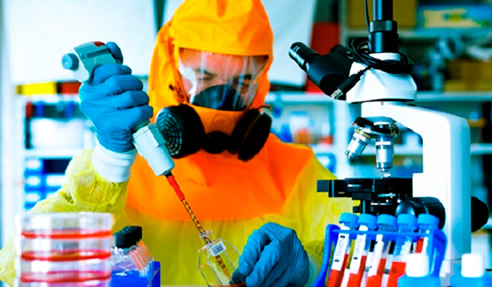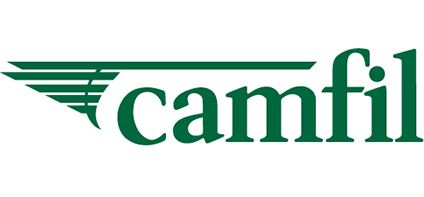Physical containment (PC) laboratories are purpose-designed, strictly controlled, and highly secured facilities that are constructed specifically for handling, testing and the containment of microorganisms. As Australia's leading national air filtration technology and solutions provider, Camfil Airepure offers a range of cost-effective and innovative containment solutions.
The following are typical substances or compounds that are confined in a containment facility:
2. Radioactive Compounds
a. Radioactive Iodine
b. Radioactive Methyl Iodide
c. Plutonium
d. Radioactive Tags
3. Carcinogenic Substances
a. Benzene
b. Chloroform
c. Carbon Tetrachloride
d. Asbestos
4. Toxic Compounds
a. Nerve agents that disrupts the mechanism of the nerves to transmit impulses
b. Pesticides
Containment Levels Physical Containment (PC) / Quarantine Containment (QC)
PC laboratories are categorised into four different levels based on the agent risk group classification. The risk grouping reflects the degree of threat involved in dealing with the microorganisms. It also rates the laboratories into different types based on the ascending stringency level of containment measures or requirements.
The four physical containment levels based on risk group along with the corresponding type of laboratory are the following:
- Risk Group 1: Physical Containment Level 1 (PC 1). This is classified as the lowest containment level found in student and undergraduate teaching laboratory. It characterises a lab work with agents that have a low degree of threat to workers. Infection due to accidental exposure is curable.
- Risk Group 2: Physical Containment Level 2 (PC 2). This level involves work with microorganisms that pose a moderate risk. It includes functioning commercial and postgraduate teaching laboratories. This level requires primary barrier in the form of appropriate safety equipment, HEPA air filtration system, as well as a significant degree of decontamination method.
- Risk Group 3: Physical Containment Level 3 (PC 3). This level includes work on more hazardous agents in facilities housing materials that pose a threat to health or outbreak. Thus, it requires control measures and regulation. In this level, the containment facility is often separated from the main building and equipped with more accurate containment systems, including HEPA air filtration system.
Containment Level Requirements for PC 3
a. 250-micron screen on incoming and outgoing ducts
b. Single pass for HEPA air filtration system on all discharges
c. HEPA filters on gauge lines
d. Requirements for Bag In/Bag Out may vary
e. Controlled airflow patterns
f. Annual testing to ensure pressure regimes, HEPA air filtration system integrity and device calibration
- Risk Group 4: Physical Containment Level 4 (PC 4). This is classified as the highest containment level. It houses materials that pose a threat to health or outbreak with no control measures. It involves work with agents that can be lethal upon transmission, such as Ebola virus. In this level, maximum barriers are required, and the containment practices and guidelines are very strict. Moreover, the facility is completely isolated and often fitted with more high-efficiency systems.
Containment Level Requirements for PC 4
a. Use of Class III cabinets
b. Incoming and outgoing air-showers with interlocked doors and set shower times
c. Disinfectant showers for body suit type
d. Decontamination areas
e. Pass through or dunk tanks for items that can't be decontaminated in the pressure sterilisers
f. Full gaseous decontamination for liquid resistant and chemical sterilisers
g. Bag In / Bag Out
Camfil Airepure Low-cost, High-Performance Airborne Containment Equipment
The high-risk environment in PC 3 and PC 4 laboratories require a highly specialised HEPA air filtration system design. In order to meet such laboratory containment requirements, Camfil Airepure offers the following solutions:
250 Micron Screens (Stainless / Synthetic)
The 250 micron, 316 stainless steel mesh insect screen is designed following the OGTR Guidelines (Office of the Gene Technology Regulator), an independent statutory holder under the Australian Government Department of Health.
The Insect Screen or Thrip Screen offers a protective barrier against insects that are going into or out of a controlled space. Pre-filters are advised for exhaust application and its rated flow of 20 Pa @ 2.5m/s.
Fluid and Gasket Seal Housings. Available in a range of bag-in/bag-out fluid and gasket seal housing series, these filter housings aid in the air filtration of toxic materials and potentially hazardous airborne particulates. One particular series also helps in the installation of a single HEPA filter or carbon adsorber, in low CFM ventilation systems.
In-place Efficiency Test Housings. It enables testing to ASME N510 standards when there are space restrictions or when isolation of a leaking filter is required.
In-Place Precision Scan. Designed to ensure that an installed filtration system meets minimum specified filtering efficiencies, this also enables the finding of pinhole leaks in filters installed inside access filter housings during scan testing.
Bubble Tight Isolation Dampers. These are specifically designed to provide cost-effective isolation of filter banks with high volumes of air.
Custom Engineered and CBR Filtration Systems. These filtration systems are designed to provide protection against chemical, biological, and radioactive warfare agents.
High-efficiency Gas Adsorbers (HEGA). HEGA aims to contain toxic gases in air filtration systems; these gas adsorbers collect gaseous contaminants from an airstream through adsorption.
High-efficiency Particulate Air (HEPA) Filters. These refer to the high-quality HEPA filters from Camfil Airepure. These HEPA filters are tested by IES-RP-CC001.3, "HEPA and ULPA filters."
Channel Seal (CS) HEPA-ULPA Ceiling Module and GSM (Gasket Seal Module) Terminal HEPA Filter Module. Gel seal-ducted and gasket seal-ducted respectively; these are designed to enable the replacement and testing of HEPA filters without disturbance to the module housing. It serves as an ideal application for facilities that require clean-room-level air filtrations, such as pharmaceutical and biotechnology facilities.
Ceiling Suspension Type (CST) Roomside Replaceable HEPA-ULPA Module and T-Bar Suspension Type (TST) Disposable-ducted HEPA/ULPA Module. Available in HEPA and ULPA-grade efficiencies, these are designed as an ideal terminal filter hoods for facilities where hoods are regularly validated for performance and leak-free operation, such as pharmaceutical and biotech cleanrooms.
AC1 HEPA Holding Frame. Designed for the permanent installation of HEPA filters in the field, this can be used to hold filters individually or in multiple filter bank arrangements. It serves as an ideal application for facilities where a permanent HEPA holding frame is required.
For more information about Camfil Airepure airborne containment and isolation solutions for PC3 and PC4 facilities, visit www.airepure.com.au. For product-related inquiries, call 1300-886-353. You can also visit Camfil Airepure online shop for product search or online purchase.






 AIRAH Product of the Year Kaire®
AIRAH Product of the Year Kaire® HEPA Box-type Compact Filters by Camfil
HEPA Box-type Compact Filters by Camfil Dust & Fume Collection Systems - Gold
Dust & Fume Collection Systems - Gold Compact Dust Collectors - Quad Pulse
Compact Dust Collectors - Quad Pulse High-temperature HEPA Filters from
High-temperature HEPA Filters from CleanSeal Terminal HEPA Housings from
CleanSeal Terminal HEPA Housings from Safe Change HEPA Filter Containment
Safe Change HEPA Filter Containment HEPA Panel Filters - Megalam by Camfil
HEPA Panel Filters - Megalam by Camfil Terminal HEPA Filter Housings -
Terminal HEPA Filter Housings - Energy Saving Ventilation Filters -
Energy Saving Ventilation Filters - In-room Air Cleaners from Camfil
In-room Air Cleaners from Camfil Filters for Food Processing - ProSafe
Filters for Food Processing - ProSafe Energy Efficient HVAC Bag Filters -
Energy Efficient HVAC Bag Filters - Chemical Media for Gaseous Filtration
Chemical Media for Gaseous Filtration Air Filtration of Commercial Buildings
Air Filtration of Commercial Buildings Manifolded Fume Exhaust System for UNSW
Manifolded Fume Exhaust System for UNSW Environmental Air Quality Control with
Environmental Air Quality Control with Disposable Air Filters from Camfil
Disposable Air Filters from Camfil Commercial Air Filtration for Kitchen
Commercial Air Filtration for Kitchen Efficient Air Filtration Systems with
Efficient Air Filtration Systems with
